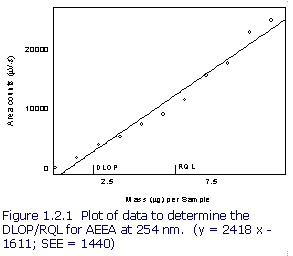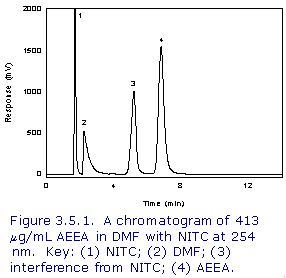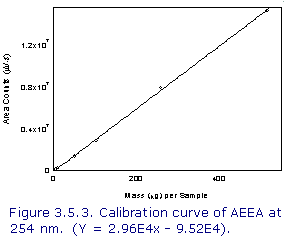1. General Discussion
1.1 Background
1.1.1 History
Air samples
collected on tubes containing XAD-2 resin coated with NITC were
received at SLTC along with a request for analysis for
aminoethylethanolamine (AEEA). This compound was collected on the same
media used in OSHA Method 601,
for diethylene triamine, so those extraction and analytical parameters
were used as a starting point for AEEA. The AEEA was found to readily
derivatize with the NITC to form a stable derivative. The mobile phase
of 80:20 isooctane:isopropanol gave a separation for the AEEA peak
from interferences from the NITC. The samples were extracted with
dimethylformamide (DMF), with an extraction efficiency mean of 99.7%
for the concentration range of 20.7 to 413 µg/tube. The retention efficiency study showed no
AEEA on the back up section of the spiked tube or back up tube, for
tubes spiked with 413.2 µg through which10-L
humid air had been drawn. The storage study showed no loss for samples
stored for up to 14 days under both refrigerated and ambient
conditions.
1.1.2 Toxic effects (This section is for
information only and should not be taken as the basis of OSHA policy.)
2,3
AEEA
is a moderate skin irritant, severe eye irritant, and moderate mucous
membrane irritant. It is moderately toxic by ingestion, skin contact,
and inhalation. It can cause skin sensitization and chemical asthma.
1.1.3 Workplace exposure4,5
AEEA
is used in textile finishing compounds such as antifuming agents,
dyestuffs, and cationic surfactants. It is used in resins, rubber
products, insecticides, and medical formulations. AEEA is listed in
EPA’s HPV (high production volume) list of chemicals produced and/or
imported into the United States.
1.1.4 Physical properties and
other descriptive information6,7
CAS number:
|
111-41-1
|
IMIS:8
|
A120
|
molecular
weight:
|
104.18
|
vapor density:
|
3.59
|
melting point:
|
<-18ºC
|
boiling point:
|
243.7ºC
|
appearance:
|
clear liquid
|
vapor
pressure:
|
0.0013 kPa @
20ºC
|
odor:
|
mild
ammoniacal
|
flash point:
|
135º C
(275ºF)(cc)
|
autoignition
|
|
density:
|
1.0304
|
temperature:
|
368ºC (695ºF)
|
molecular
formula:
|
C4H12N2O
|
solubility:
|
water, alcohol,
acetone
|
synonyms:
|
N-(2-aminoethyl)ethanolamine;
2-[(2-aminoethyl)amino] ethanol;
N-hydroxyethyl-1,2-thanediamine; hydroxyethylethylenediamine;
monoethanolethylenediamine
|
| structural
formula: |
 |
This method was evaluated according to the OSHA SLTC
"Evaluation Guidelines for Air Sampling Methods Utilizing
Chromatographic Analysis"9.
The Guidelines define analytical parameters, specify required laboratory
tests, statistical calculations and acceptance criteria. The analyte air
concentrations throughout this method are based on the recommended
sampling and analytical parameters.
1.2 Detection limit of the overall procedure
(DLOP) and reliable quantitation limit (RQL)
The DLOP is
measured as mass per sample and expressed as equivalent air
concentrations, based on the recommended sampling parameters. Ten
samplers were spiked with equal descending increments of analyte, such
that the highest sampler loading was 10.34 µg
of AEEA. This is the amount spiked on a sampler that would produce a
peak at least 10 times the response for a sample blank. These spiked
samplers were analyzed with the recommended analytical parameters, and
the data obtained used to calculate the required parameters (standard
error of estimate (SEE) and slope) for the calculation of the DLOP. The
slope was 2418 and the SEE was 1440. The RQL is considered the lower
limit for precise quantitative measurements. It is determined from the
regression line parameters obtained for the calculation of the DLOP,
providing 75% to 125% of the analyte is recovered. The DLOP and RQL were
1.79 µg and 5.96 µg
respectively. The recovery at the RQL was 97.2%.

|
Table
1.2
Detection Limit of the Overall Procedure
for AEEA
|
| mass per sample
(µg) |
area counts
(µV·s) |
|
0.00
1.03
2.07
3.10
4.14
5.17
6.20
7.24
8.27
9.31
10.34
|
0
1733
3890
5287
7345
9023
11528
15632
17639
22873
24876
|
|
Below is the
chromatogram of the RQL level.
2.
Sampling Procedure
All safety practices that apply to the work
area being sampled should be followed. The sampling equipment should be
attached to the worker in such a manner that it will not interfere with
work performance or safety.
2.1 Apparatus
2.1.1 Samples are collected using a
personal sampling pump calibrated, with the sampling device attached,
to within ±5% of the recommended flow rate.
2.1.2 Samples are
collected with 7-cm × 4-mm i.d. × 7-mm o.d. glass sampling tubes
packed with two sections (80/40 mg) of XAD-2 resin coated with 10% by
weight 1-naphthylisothiocyanate. The sections are held in place and
separated with glass wool plugs. For this evaluation, commercially
prepared sampling tubes were purchased from SKC, Inc. (catalog no.
226-30-18). 2.2 Reagents
None required.
2.3 Technique
2.3.1 Immediately before sampling,
break off the ends of the flame-sealed tube to provide an opening
approximately half the internal diameter of the tube. Wear eye
protection when breaking ends. Use tube holders to minimize the hazard
of broken glass. All tubes should be from the same lot.
2.3.2
The smaller section of the adsorbent tube is used as a back-up and is
positioned nearest the sampling pump. Attach the tube holder to the
sampling pump so that the adsorbent tube is in an approximately
vertical position with the inlet facing down during sampling. Position
the sampling pump, tube holder and tubing so they do not impede work
performance or safety.
2.3.3 Draw the air to be sampled
directly into the inlet of the tube holder. The air being sampled is
not to be passed through any hose or tubing before entering the
sampling tube.
2.3.4 After sampling for the appropriate time,
remove the adsorbent tube and seal it with plastic end caps. Seal each
sample end-to-end with an OSHA-21 form as soon as possible.
2.3.5 Submit at least one blank sample with each set of
samples. Handle the blank sample in the same manner as the other
samples except draw no air through it.
2.3.6 Record sample air
volumes (liters), sampling time (minutes) and sampling rate (L/min)
for each sample, along with any potential interferences on the
OSHA-91A form.
2.3.7 Submit the samples to the laboratory for
analysis as soon as possible after sampling. If delay is unavoidable,
store the samples at refrigerator temperature. Ship any bulk samples
separate from the air samples. 2.4 Extraction efficiency
The extraction
efficiency was determined by spiking NITC-coated XAD-2 tubes with AEEA
at 0.1 to 2 times the target concentration. These samples were stored
overnight at ambient temperature. Samples were extracted with 2-mL DMF,
shaken for 30 minutes, and analyzed. The mean extraction efficiency over
the studied range was 99.7%. The wet extraction efficiency was
determined at 1 times the target concentration by spiking the analyte
onto NITC-coated XAD-2 tubes which had 10-L humid air (absolute humidity
of 15.9 mg/L of water, about 80% relative humidity at 22.2ºC) drawn
through them immediately before spiking. The mean recovery for the wet
samples was 98.7%.
Table
2.4
Extraction Efficiency (%) of AEEA
|
| level |
sample number |
|
|
| × target concn |
µg per sample |
1 |
2 |
3 |
4 |
5 |
6 |
mean |
|
0.1
0.25
0.5
1.0
1.5
2.0
1.0(wet) |
20.7
51.7
103
207
310
413
207 |
99.2
99.8
98.3
100.8 99.5
99.8
98.9 |
98.5
98.7
98.2
100.9 100.1 101.2
99.2 |
99.8 100.1 99.3
98.7
100.3 98.5
99.9 |
98.8
98.5
99.8
99.9
98.9
99.6
97.3 |
100.1 100.4 101.0
98.4
99.7 100.5
97.2 |
100.4 100.3 100.4 100.3
100.1 100.3
99.5 |
99.5
99.6
99.5
99.8
99.8
100.0
98.7 |
|
2.5 Retention
efficiency
Six NITC-coated XAD-2 tubes were spiked with 413
µg (9.7 ppm) of AEEA and allowed to
equilibrate for 4 h. Each spiked tube was placed in series with a second
NITC-coated XAD-2 tube. Each sampling train had 10-L humid air (absolute
humidity of 15.9 mg/L of water, about 80% relative humidity at 22.2ºC)
pulled through it at 0.1 L/min. The samples were extracted and analyzed.
The mean recovery was 99.4%. There was no analyte found on the backup
section of any of the spiked tubes or on the second
tubes.
Table
2.5
Retention Efficiency (%) of AEEA
|
|
sample number |
|
| section |
1 |
2 |
3 |
4 |
5 |
6 |
mean |
|
front of spiked tube
rear of spiked
tube
front of series tube
back of series
tube
total |
98.8
0.0
0.0
0.0
98.8 |
97.7
0.0
0.0
0.0
97.7 |
99.7
0.0
0.0
0.0
99.7 |
100.6
0.0
0.0
0.0
100.6 |
100.2
0.0
0.0
0.0
100.2 |
99.6
0.0
0.0
0.0
99.6 |
99.4
0.0
0.0
0.0
99.4 |
|
2.6 Sample storage
Fifteen NITC-coated XAD-2 tubes were each spiked with 207 µg (4.86 ppm) of AEEA. They were allowed to
equilibrate for 4 h, then 10-L of air, with an absolute humidity of 15.7
milligrams of water per liter of air (about 80% relative humidity at
23ºC), was drawn through them. Three samples were analyzed immediately.
The remaining tubes were sealed and six were stored at room temperature
(23ºC), while the other six were stored at refrigerated temperature
(4ºC). Three of the samples stored at room temperature and three of the
samples stored at refrigerated temperature were analyzed after 7 days
and the remaining three of each group after 14 days. The results
indicate good storage stability for the time period studied.
Table
2.6
Storage Test for AEEA
|
time
(days) |
ambient
storage
recovery (%) |
|
refrigerated
storage
recovery (%) |
|
0
7
14 |
99.8
99.7
99.6 |
100.5
98.5
97.8 |
98.5
99.1
99.5 |
|
99.8
98.6
99.4 |
100.5
98.9
98.7 |
98.5
99.1
99.3 |
|
2.7 Recommended air
volume and sampling rate.
Based on the data collected in this
evaluation, 10-L air samples should be collected at a sampling rate of
0.1 L/min for 100 minutes.
2.8 Interferences
(sampling)
2.8.1 There are no known compounds
which will severely interfere with the collection of AEEA. Other
primary and secondary amines will collect on this medium, and form
derivatives with the NITC, affecting the ability of the tube to
collect AEEA, so sampling time should be adjusted if high
concentrations of amines are expected.
2.8.2 Suspected
interferences should be reported to the laboratory with submitted
samples. 3.
Analytical Procedure
Adhere to the rules set down in your Chemical
Hygiene Plan. Avoid skin contact and inhalation of all chemicals and
review all appropriate MSDSs.
3.1 Apparatus
3.1.1 A liquid chromatograph equipped
with a UV detector. For this evaluation, a Waters 600 Controller and
pump were used, with a Waters 2487 Dual Wavelength Absorbance
Detector, and a Waters 717 plus Autosampler was used.
3.1.2 An
LC column capable of separating AEEA from the extraction solvent and
any potential interferences. A 4.6 × 250 mm column packed with 5-µm Bakerbond cyanopropyl (JT Baker, Phillipsburg,
NJ) was used in the evaluation.
3.1.3 An electronic integrator
or some other suitable means of measuring peak areas. A Waters
Millennium32 Data System was used in this
evaluation.
3.1.4 Glass vials with
poly(tetrafluoroethylene)-lined caps. For this evaluation 4-mL vials
were used.
3.1.5 A dispenser capable of delivering 2.0 mL of
extracting solvent to prepare standards and samples. If a dispenser is
not available, a 2.0-mL volumetric pipet may be used.
3.1.6
Volumetric flasks - 10-mL and other convenient sizes for preparing
standards. 3.2
Reagents
3.2.1 Aminoethylethanolamine (AEEA),
reagent grade. Acros 99% (lot 08515DS labeled
2-(2-aminoethyamine)ethanol) was used in this evaluation.
3.2.2 N,N-Dimethyl formamide (DMF),
reagent grade. Fisher 99.5%+ (lot 933764) was used for this
evaluation.
3.2.3 Isopropyl alcohol, HPLC grade. Fisher 99.9%
(lot 0011554) was used in this evaluation.
3.2.4 Isooctane,
HPLC grade. Fisher 99.0%+ (lot 024943) was used in this evaluation.
3.2.5 1-Naphthylisothiocyanate (NITC), reagent grade. Aldrich
95%+ (lot 09925MY) was used in this evaluation.
3.2.6 Mobile
phase was 80:20 isooctane:isopropyl alcohol. 3.3 Standard preparation
3.3.1 Freshly prepare two stock
standards. A stock standard of 2 mg/mL may be prepared by a) weighing
out about 50 mg of NITC in a 10-mL flask, b) weigh out 20 mg AEEA by
placing the drops on top of the NITC in the flask, and c) weigh out
about 50 mg more NITC on top of the AEEA, making sure that the AEEA is
covered on all sides by the NITC. Allow the AEEA to react with the
NITC for at least 1 hour before adding the DMF. Partially fill the
volumetric flask with DMF and allow to sit 30 minutes to begin
dissolving the derivative, then swirl the contents until all of the
solids are dissolved, and fill to the mark with DMF. Do not place the
flask in a sonic bath to try to get the derivative to go into
solution, as it will destroy the derivative. There must always be an
excess of the NITC for the derivative to be completely formed. There
are two amine groups which will react with the NITC, so this mole
ratio must be used in calculating the amount of NITC to be added. For
example, the amount of NITC needed for the above stock standard would
be calculated:
20 mg AEEA × (NITC MW=185.25/AEEA
MW=104.15) ×2 = 71 mg In the
above stock standard preparation a total of 100 mg NITC was weighed
out so that an excess of NITC was present.
3.3.2 Diluted
standards are prepared with a solution of 1 mg/mL NITC in DMF, so that
an excess of NITC is always present. Bracket sample concentrations
with working standard concentrations. If sample concentrations are
higher than the concentration range of prepared standards, either
analyze higher standards, or dilute the sample. The higher standards
should be at least as high in concentration as the highest sample.
Diluted samples should be prepared with a solution of 1 mg/mL NITC in
the DMF. The range of standards used in this study was from 0.5 to 250
µg/mL. The instrument is calibrated on the
amount of AEEA in each standard. 3.4 Sample preparation
3.4.1 Remove the plastic end caps from
the sample tubes and carefully transfer the adsorbent sections to
separate 4-mL vials. Discard the glass tube and glass wool
plugs.
3.4.2 Add 2.0 mL of DMF to each vial.
3.4.3
Immediately seal the vials with poly(tetrafluoroethylene)-lined
caps.
3.4.4 Agitate the vials on a shaker, or a rotator, for 30
minutes. 3.5 Analysis
3.5.1 HPLC conditions
column:
|
Bakerbond
cyanopropyl (CN) column 4.6 × 250 mm
|
| injection size: |
10 µL
|
| mobile phase: |
1 mL/min 80:20
isooctane:isopropyl alcohol
|
| detector: |
UV at 254 and 280
nm
|
| run time: |
14 min
|
| retention times: |
1.7 min NITC
2.2
min DMF
6.8 min AEEA | |

|
3.5.2 Peak
areas are measured by an integrator or other suitable means.

3.5.3 An external standard (ESTD) calibration method is used. A
calibration curve can be constructed by plotting response of standard
injections versus micrograms of analyte per sample. Bracket the
samples with freshly prepared analytical standards over a range of
concentrations.
3.6 Interferences (analytical)
3.6.1 Any compound that produces a LC
response and has a similar retention time as the analyte is a
potential interference. If any potential interferences were reported,
they should be considered before samples are extracted. Generally,
chromatographic conditions can be altered to separate an interference
from the analyte.
3.6.2 When necessary, the identity or purity
of an analyte peak may be confirmed by a photodiode array scan of the
peak, by wavelength ratioing, or by LC/mass spec.
3.7 Calculations
The amount of
analyte per sampler is obtained from the appropriate calibration curve
in terms of micrograms per sample, uncorrected for extraction
efficiency. This total amount is then corrected by subtracting the total
amount (if any) found on the blank. The air concentration is calculated
using the following formulas.
 |
where: |
CM is concentration by weight
(mg/m³)
M is micrograms per
sample
V is liters of air
sampled
EE is extraction
efficiency, in decimal form
|
 |
where: |
CV is concentration by volume
(ppm)
VM is molar volume
at 25ºC and 760 mm = 24.46
CM is concentration by
weight
Mr is molecular
weight = 104.18 | 4. Recommendations for further study
Collection,
reproducibility, and other detection limit studies need to be performed to
make this a validated method.
1OSHA Sampling and
Analytical Methods. http://www.osha-slc.gov/dts/sltc/methods/index.html
(accessed 5/21/2002).
2Lewis, R., Sax’s Dangerous Properties of Industrial Materials,
Van Nostrand Reinhold: New York, 2002, p 176.
3Pepys,
J., Asthma due to Inhaled Chemical Fumes: Amino-ethyl ethanolamine in
Aluminum Soldering Flux, Clin Allergy, 1972,
2(2), 197-204.
4Lewis, R., Ed, Hawley’s Condensed Chemical Dictionary, John Wiley
& Sons: New York, 2001, p 592.
5HPV Chemical List
History. http://www.osha-slc.gov/pls/oshaweb/owaredirect.html?p_url=http://www.epa.gov/opptintr/chemrtk/opptsrch.htm
(accessed 5/21/2002).
6Lewis, R., Sax’s Dangerous Properties of Industrial Materials,
Van Nostrand Reinhold: New York, 2002, p
176.
7Cheminfo http://www.osha-slc.gov/pls/oshaweb/owaredirect.html?p_url=http://ccohs.ca/products/databases/cheminfo.html(accessed
5/21/2002).
8OSHA Chemical Sampling
Information http://www.osha-slc.gov/dts/chemicalsampling/toc/toc_chemsamp.html
(accessed 5/21/2002).
9Burright, D.; Chan, Y.;
Eide, M.; Elskamp, C.; Hendricks, W.; Rose, M. C. Evaluation Guidelines for Air Sampling Methods Utilizing
Chromatographic Analysis; OSHA Salt Lake Technical Center, U.S.
Department of Labor: Salt Lake City, UT, 1999.
|

